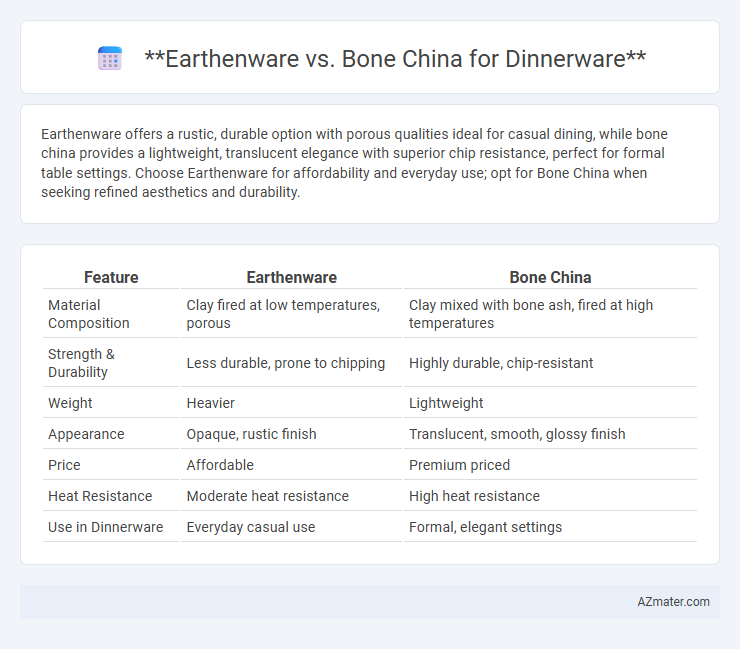Earthenware offers a rustic, durable option with porous qualities ideal for casual dining, while bone china provides a lightweight, translucent elegance with superior chip resistance, perfect for formal table settings. Choose Earthenware for affordability and everyday use; opt for Bone China when seeking refined aesthetics and durability.
Table of Comparison
| Feature | Earthenware | Bone China |
|---|---|---|
| Material Composition | Clay fired at low temperatures, porous | Clay mixed with bone ash, fired at high temperatures |
| Strength & Durability | Less durable, prone to chipping | Highly durable, chip-resistant |
| Weight | Heavier | Lightweight |
| Appearance | Opaque, rustic finish | Translucent, smooth, glossy finish |
| Price | Affordable | Premium priced |
| Heat Resistance | Moderate heat resistance | High heat resistance |
| Use in Dinnerware | Everyday casual use | Formal, elegant settings |
Introduction to Earthenware and Bone China
Earthenware and bone china are two popular types of ceramic dinnerware, each with distinct characteristics and uses. Earthenware is made from natural clay fired at lower temperatures, resulting in a porous, durable material often finished with a colorful glaze. Bone china incorporates bone ash into its porcelain mix, producing a lightweight, translucent, and highly durable dinnerware favored for its elegant appearance and strength.
Composition and Manufacturing Processes
Earthenware consists primarily of clay fired at lower temperatures (1,000-1,150degC), resulting in a porous, opaque material that requires glazing for durability, whereas bone china incorporates bone ash, kaolin, and feldspar, fired at higher temperatures (1,200-1,250degC), creating a translucent, strong, and vitrified ceramic. The manufacturing of earthenware involves shaping raw clay, drying, then bisque firing followed by glazing and a final glaze firing, while bone china production requires mixing powdered raw materials, casting or molding, bisque firing, glazing, and a high-temperature glaze firing to achieve its delicate finish and mechanical strength. Bone china's inclusion of bone ash improves whiteness and translucency, making it preferred for high-end dinnerware, whereas earthenware's cost-effective process produces more rustic and everyday-use pieces.
Appearance and Aesthetic Appeal
Earthenware offers a rustic, handcrafted appearance with a matte or slightly textured finish, providing a warm, casual aesthetic suitable for everyday use. Bone China boasts a translucent, glossy surface with intricate detailing and a refined, elegant look that enhances formal dining settings. The delicate whiteness and smooth glaze of Bone China give it a luxurious appeal compared to the more robust and earthy tones of Earthenware.
Durability and Strength Comparison
Bone china exhibits superior durability and strength compared to earthenware, thanks to its high calcium phosphate content derived from animal bones, which enhances its toughness and resistance to chipping. Earthenware is more porous and less dense, making it more susceptible to cracks and breakage under impact or thermal stress. For long-lasting dinnerware that withstands daily use and frequent washing, bone china remains the preferred choice due to its enhanced mechanical properties and refined manufacturing process.
Weight and Handling Differences
Earthenware dinnerware is generally heavier and thicker, offering a sturdy feel but can be more cumbersome to handle during use and washing. Bone china, known for its lightweight and delicate nature, provides effortless handling and a refined elegance without compromising durability. These weight and handling differences influence the choice of dinnerware based on comfort and practical daily use.
Suitability for Everyday Use and Special Occasions
Earthenware offers durability and affordability, making it highly suitable for everyday use with its resistance to chipping and casual aesthetic. Bone china, prized for its delicate translucency and refined appearance, excels in special occasions, delivering an elegant dining experience. Both materials balance functionality and style but differ in weight, fragility, and visual appeal, guiding consumers based on frequency of use and event formality.
Safety: Lead Content and Food Compatibility
Earthenware dinnerware often contains higher levels of lead and cadmium, posing potential health risks if not properly glazed and fired. Bone china is typically safer, as it is manufactured with strict regulations limiting lead content, ensuring food compatibility without harmful leaching. Choosing bone china reduces the risk of toxic metal exposure, making it a preferred option for food safety-conscious consumers.
Maintenance, Cleaning, and Care
Earthenware dinnerware requires gentle handwashing with mild detergent to prevent chipping and is often not dishwasher safe due to its porous nature and lower durability. Bone china, known for its strength and non-porous surface, can typically withstand dishwasher cleaning and resists staining, making it easier to maintain over time. Proper care for earthenware includes avoiding rapid temperature changes, while bone china demands less cautious handling but benefits from using non-abrasive cleaners to preserve its translucent finish.
Price Range and Investment Value
Earthenware dinnerware generally falls within an affordable price range, making it accessible for everyday use and casual dining, whereas bone china commands a higher price due to its refined composition and elegant appearance. Bone china offers superior durability, translucency, and sophistication, often regarded as a long-term investment valued for both its aesthetic appeal and resilience. Collectors and enthusiasts typically favor bone china for its potential to retain or appreciate in value over time, while earthenware suits budget-conscious consumers prioritizing practicality over prestige.
Choosing the Right Dinnerware for Your Needs
Earthenware offers a rustic charm and affordability, making it ideal for casual dining and everyday use, while Bone China provides elegance, durability, and chip resistance suited for formal occasions and long-term use. Consider the level of durability needed, microwave and dishwasher compatibility, and style preferences when choosing between these materials. Selecting the right dinnerware depends on balancing practicality with aesthetic appeal to match your lifestyle and dining habits.

Infographic: Earthenware vs Bone China for Dinnerware
 azmater.com
azmater.com